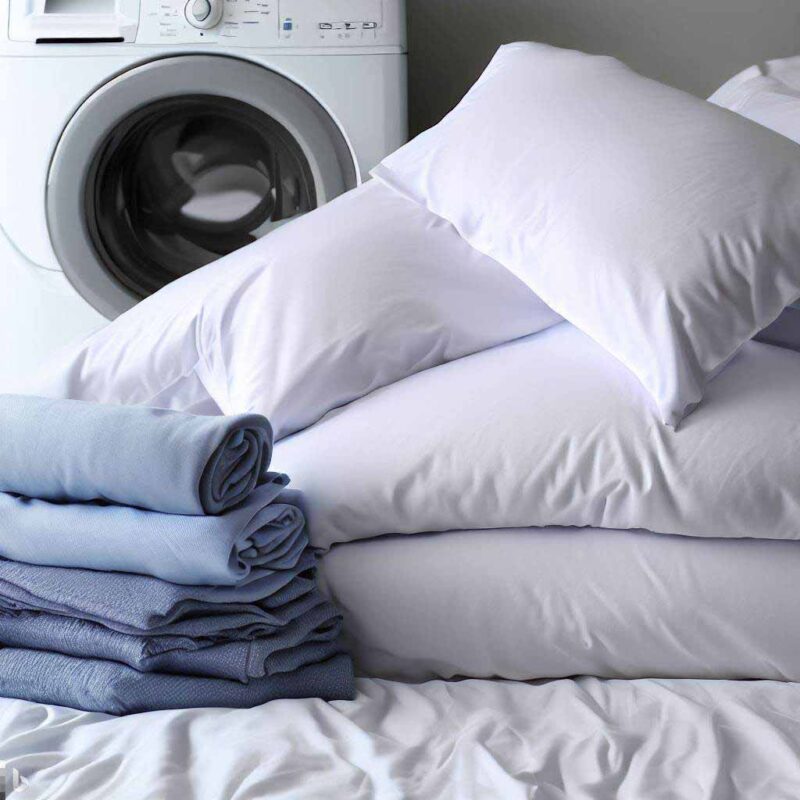Caring for Your Decor, News
How to Wash Bedsheet for a Fresh and Clean Sleep
Your bedsheet is one of the most important items in your bedroom. It comes in contact with your skin every night, so it needs to be clean and comfortable. But did you know that your bed sheets can harbor millions of bacteria, dust mites, and allergens that can affect your health and sleep quality? How often should you wash your bedsheet? And what is the best way to do it? In this post, we will answer these questions and give you some tips on how to wash bedsheet properly.

How Often Should You Wash Your Bedsheet?
According to experts, you should wash your bedsheet at least once every two weeks, or more often if you sweat a lot, have allergies, or share your bed with pets. Washing your bedsheet regularly will help remove dust mites, bacteria, dead skin cells, and body oils that can accumulate on the fabric and cause odors, stains, and skin irritation.
How to Wash Your Bedsheet by Fabric Type
Before you wash your bedsheet, you should check the care label on the fabric to see if it has any special washing instructions. Different fabrics may require different water temperatures, detergents, and drying methods. Here are some general guidelines for washing common types of bedsheet fabrics:
- Cotton: Cotton is a durable and breathable fabric that can withstand high water temperatures. You can wash cotton sheets in hot water (around 100 degrees Fahrenheit) to kill germs and allergens. Use a heavy-duty laundry detergent to remove body oils and soil from cotton sheets.
- Polyester or microfiber: Polyester or microfiber sheets are synthetic fabrics that are wrinkle-resistant and easy to care for. You can wash polyester or microfiber sheets in cool or warm water (around 86 degrees Fahrenheit) with a normal laundry detergent. Avoid using bleach or fabric softener on these fabrics, as they can damage the fibers.
- Silk: Silk is a delicate and luxurious fabric that needs gentle handling. You can wash silk sheets by hand in cold water (around 68 degrees Fahrenheit) with a mild detergent. Do not use bleach, vinegar, or stain remover on silk, as they can ruin the color and texture of the fabric.
How to Pre-Treat Stains on Your Bedsheet
If you notice any stains on your bedsheet before washing it, you should pre-treat them with a stain remover or a natural alternative. Here are some common types of stains and how to remove them:
- Blood: Soak the stained area in cold water for 10 minutes, then rub some hydrogen peroxide on it. Rinse well and repeat if needed.
- Cosmetics: Dab a mixture of water and liquid dish detergent onto the stain, and then gently rub. Repeat until the makeup stain is gone, and then wash as usual.
- Coffee: Mix 1 quart of water, 1/2 teaspoon of liquid dish detergent, and 1 tablespoon of white vinegar in a bucket or bowl. Submerge the section of the sheet that’s stained and let it soak for 15 minutes. Rinse well and wash as usual.
How to Dry Your Bedsheet Properly
After washing your bedsheet, you should dry it properly to prevent wrinkles, shrinkage, or damage. Here are some tips on how to dry your bedsheet depending on the fabric type:
- Cotton: You can dry cotton sheets on a low heat setting in the dryer to minimize wrinkles. Avoid the hot cycle for all fabrics, as heat can wear out fabric and damage the elastic on fitted sheets. When possible, air-dry your sheets outdoors on a sunny day using a clothesline. The sun is a natural disinfectant and brightener. To remove wrinkles, fluff them up for a few minutes in the dryer afterward.
- Polyester or microfiber: You can also dry polyester or microfiber sheets on a low heat setting in the dryer or air-dry them outdoors. These fabrics are wrinkle-resistant, so you don’t need to iron them.
- Silk: You should never put silk sheets in the dryer, as they can shrink or lose their shape. Instead, air-dry them indoors away from direct sunlight or heat sources. You can iron silk sheets on a low heat setting if needed.
How to Store Your Bedsheet Correctly
Once your bedsheet is clean and dry, you should store it correctly to keep it fresh and neat. Here are some tips on how to store your bedsheet:
- Fold your bedsheet neatly and stack them by size and color in a closet or drawer.
- Avoid storing your bedsheet in plastic bags or containers, as they can trap moisture and cause mold or mildew growth.
- Use lavender sachets or cedar blocks to keep your bedsheet smelling nice and repel moths.
Conclusion
Washing your bedsheet regularly is essential for your health and comfort. By following these tips on how to wash bedsheet properly, you can enjoy a fresh and clean sleep every night.
>>> If you want to learn more about duvet covers, you should visit Reverlavie. Reverlavie is an online store that provides a wide range of duvet covers for different purposes and occasions. You can find useful information and tips on how to choose and care for your duvet covers at Reverlavie.

